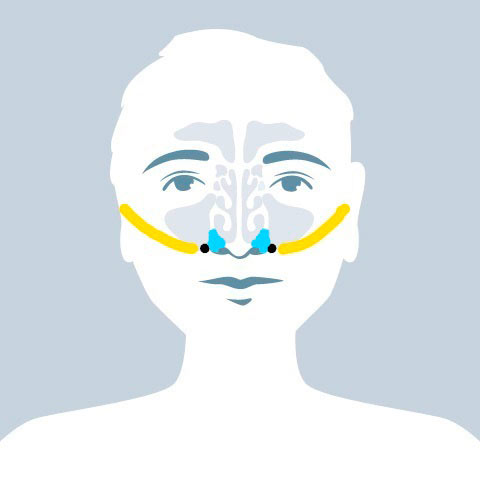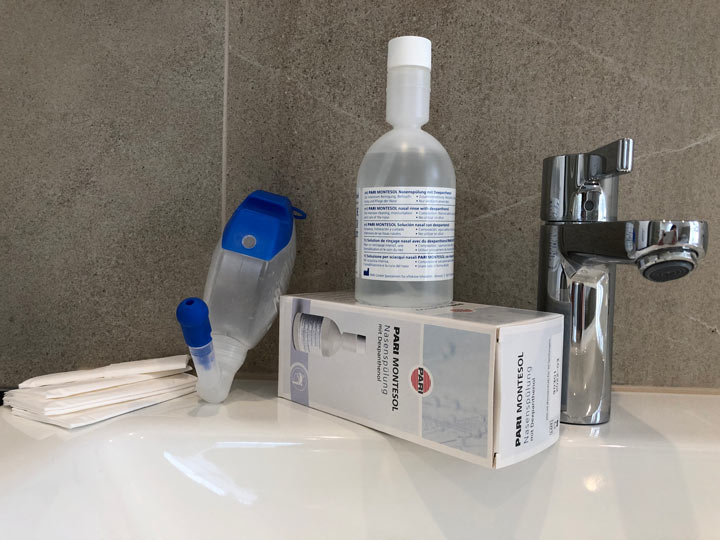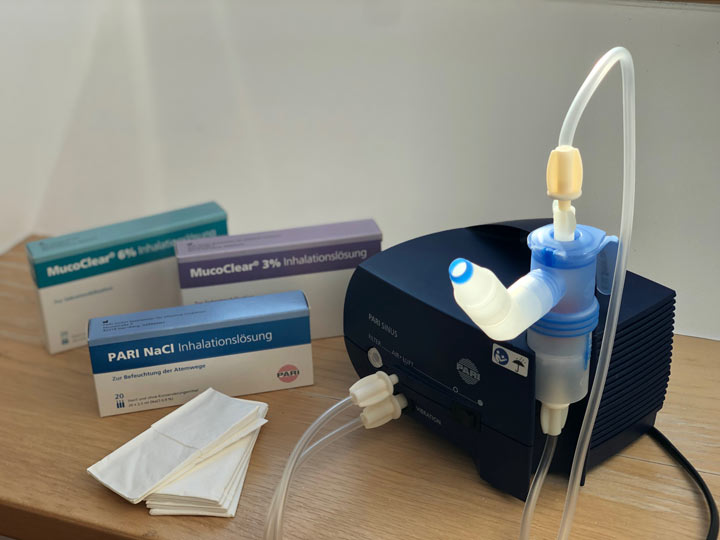A blocked or runny nose is unpleasant whether due to a cold, sinusitis or even allergies. Here are some tips on how you can breathe freely again.
Most people have runny or blocked noses from a cold caused by a viral infection. If the runny nose just won’t go away and accompanied by a feeling of pressure and a headache, it might be due to sinusitis (inflammation of the nasal sinuses). If the runny nose recurs annually in the spring or summer and it is accompanied by sneezing and itchy eyes, hay fever from allergies should be considered. If you suspect sinusitis or an allergy-related runny nose, you should have a doctor look into it in any case.
The bad news first: Unfortunately, no. You cannot get rid of blocked or runny nose due to a cold more quickly by doing anything in particular. You have to wait until the blocked or runny nose has run its course. The body simply needs a certain amount of time to fight and eliminate the virus causing the blocked or runny nose. Once the pathogens are out of the body, the problem of nasal congestion will automatically go away.
In contrast to a blocked or runny nose from a cold, time unfortunately will not cure hay fever or sinusitis. In those cases it is highly recommended to see a doctor so they can determine the cause and prescribe the appropriate treatment.
But now the good news: There are definitely things you can do to reduce the unpleasant symptoms of a cold, such as a runny or blocked nose, sneezing and tissue chunks.
Regardless of the cause of the nasal congestion, these 6 tips can help you breathe freely out of your stuffy nose again.
Nasal congestion is sometimes accompanied by a sensation of unpleasant to painful pressure in one’s head. This feeling of pressure is caused by nasal mucus which does not drain out well enough.
By doing a couple simple steps you can promote mucus flow and ease the feeling of pressure in your head. Physiotherapist Marlies Ziegler, who often treats patients with nasal problems, is familiar with the acupressure points for nasal congestion and a feeling of pressure. “I have had good experiences with acupressure for patients with cystic fibrosis, patients with rhinosinusitis and patients with nasal polyps. I give them acupressure as ‘homework’. The patients often report back that this often reduces their symptoms and discomfort. I myself use the acupressure points when I have nasal congestion from a cold. It provides short-term relief and improvement,” says the physiotherapist.
She goes on to say, “It is normal for it to hurt a bit when applying the acupressure, especially with nasal congestion. But afterward there is a feeling of release and it may feel warm to the touch. For acupressure or acupuncture for nasal congestion these spots are often worked in combination with other pressure points. Acupressure stimulates blood flow, which can trigger the positive effect.”
The LI 20 or Long Intestine 20 point is located next to the nostrils at the base of the nose. Press this point or massage it with your index or middle finger for half a minute. Repeat several times a day as needed.
Use a finger, for example your index finger, to feel the bony edge of the nose at the side of one nostril. This is the part of the nose where the soft cartilage ends and the hard bone begins. Press your fingertip against the bony edge of the nose. Imagine that you want to grip under this edge with your finger. Afterward stroke along the bony edge of your nose. Do these steps on both sides of the nose, one after the other. Each side can take 20 seconds or longer.
With one or more fingers sweep along your cheekbone from your nose to your ear. Firmly sweep along the bone, staying in contact with the bone as firmly as possible. This sweeping motion works, like other acupressure movements, because blood flow is stimulated in spots where nasal secretions are trapped.

The use of saline nasal sprays is recommended for mild colds or to prevent the nasal mucosa from drying out. Dry mucous membranes should be avoided, since they are more susceptible to cold viruses. When using a nasal spray you should make sure you buy a product which does not cause drug tolerance so you can use it for long periods without worrying about this effect occurring.
“Sprays with a tolerance effect are mostly decongestant nasal sprays. They should only used for a short time and/or only when advised to do so by a doctor. The sprays can also be used to open up the connection between your nose and ears. This allows fluid, such as that which forms when you have media otitis, to drain out of the ear. For a ‘normal’ cold, soothing nasal ointments and nasal sprays should suffice”, says physiotherapist Marlies Ziegler.
Nasal shower with Sole (saline solution) clears mucus from the nose and removes severe encrustation. It also moistens the mucous membranes, helping protect them from drying out. Pollen, dust and other contaminants from inhaled air are also flushed out of the nose, which can be helpful for nasal congestion caused by allergies.
With nasal rinse the saline solution comes into contact with even hard-to-reach areas of the nasal mucous membranes. The physical effect of an isotonic or hypertonic saline solution causes nasal mucus to become less viscous and to drain out more rapidly.
According to the physiotherapist, the advantage of nasal rinses is that, “...Nasal shower is usually simple to perform. They are also a good preventative measure during cold season, one that I like to use as well. Whenever I feel a cold coming on, I do nasal rinse once or twice a day.”

According to Marlies Ziegler, nasal rinse is recommended in many situations:
One way to open up your nose and sinuses is to use special nebulisers for upper airways. Physiotherapist Marlies Ziegler is familiar with these devices because some of her patients rely on them. She says, “While inhalation with a special inhaler for nasal inhalation like the PARI Sinus, would surely be helpful for a normal cold, it would be ‘using a sledgehammer to crack a nut’. You would have to get, and pay for yourself, the professional nebuliser for upper airways at a pharmacy or online. But if a patient has major, recurring nasal problems, their doctor can usually prescribe a PARI Sinus. For patients who have chronic nasal congestion and nasal problems, pain or nasal polyps, then I heartily recommend nasal inhalation with this device. It transports the inhalation solution via sinus waves into the sinuses. This helps the inhaled solution better liquefy the mucus trapped there. For patients with chronic rhinosinusitis, cystic fibrosis or sometimes even patients with nasal polyps, the PARI Sinus is often part of their treatment regimen.”

If you opt to blow your nose into a tissue, make sure you do the following:
If you sniff up into your nose the following is advisable:
The best thing, however, is not getting a cold at all. Regular nasal shower can help prevent colds and nasal congestion because viruses and bacteria are being continually flushed out of the nose. To prevent others from catching colds, it is recommended that you throw away used tissues straight away and wash your hands thoroughly every time you blow your nose. Of course, nasal congestion caused by allergies is not contagious. And chronic sinusitis is contagious only under certain conditions.
PARI offers a wide range of products which help you fight nasal congestion and unpleasant cold symptoms. All products are available at brick-and-mortar pharmacies, online pharmacies and in some large online shops.
NOTE: The information in this blog post is not a treatment recommendation. The needs of patients vary greatly from person to person. The treatment approaches presented should be viewed only as examples. PARI recommends that patients always consult with their physician or physiotherapist first.
You might find this interesting:
A post by the PARI BLOG editors in collaboration with physiotherapist Marlies Ziegler.
© 2025 PARI GmbH Spezialisten für effektive Inhalation